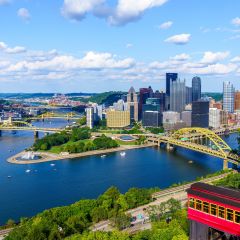

Success Story
The City of Pittsburgh is rich with scenic resources of citywide and regional significance. The City is dedicated to protecting, growing and maintaining the urban forest as they work towards Mayor William Peduto’s target to plant 100,000 trees over the next 10 years and additional urban forest targets as outlined in the Climate Action Plan. Pittsburgh’s ONEPGH Resilience Strategy highlights tree canopy as a first line of defense against a changing climate. To responsibly reach urban forest goals in a way that builds resilience and equity, Pittsburgh’s Shade Tree Commission developed an Equitable Street Tree Investment Strategy to direct investments towards low income, minority neighborhoods with low canopy coverage.
When serving as City Councilman, Mayor Peduto amended the zoning code with the View Protection Overlay District in order to protect and preserve trees during development to maintain the city’s scenic quality. As Mayor he issued an Executive Order on Tree Protection for City departments and authorities to work collaboratively to further protect Pittsburgh’s 36 percent tree canopy coverage. In 2016, he led the City to acquire 653-acres of property known as Hays Woods and dedicated the site for public use in perpetuity. This acquisition protected it from prior plans involving strip mining, a racetrack and casino development. The Hays Woods site and its irreplaceable natural attributes is one of the largest tracts of urban greenspace protected east of the Mississippi in the last 100 years.











